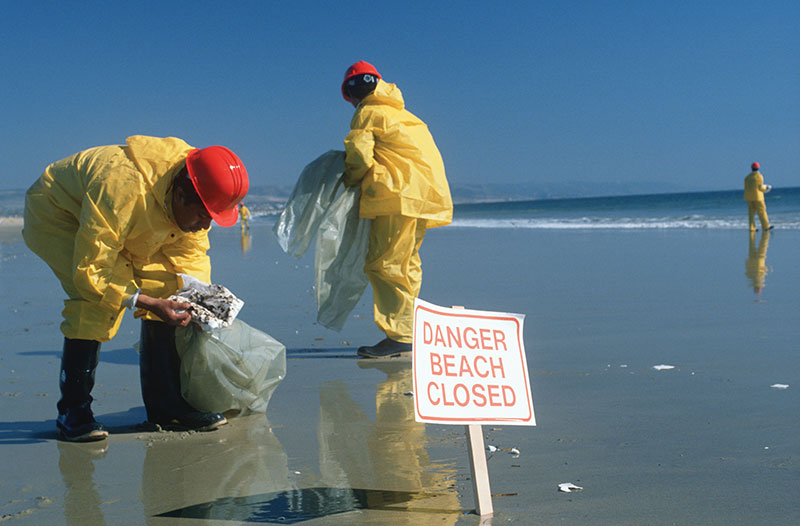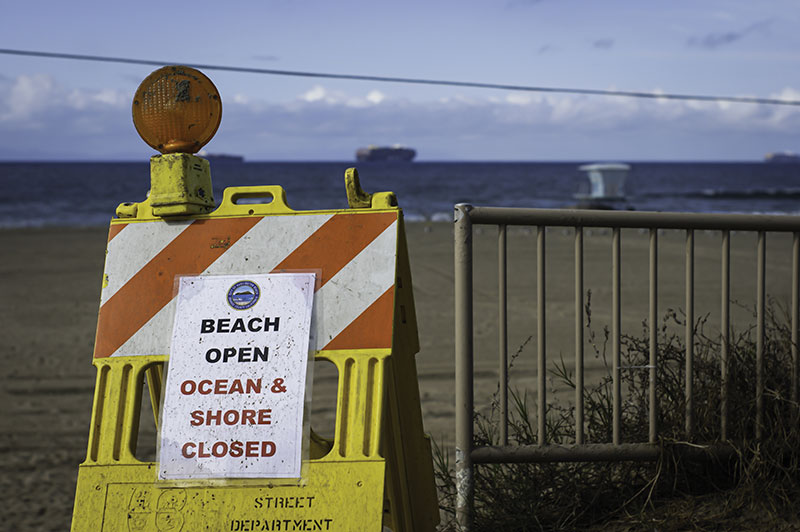December 2021, Vol. 248, No. 12
Features
Southern California Oil Spill: Unfortunate Harbinger for Future Industry Distrust
By Richard Nemec, Contributing Editor
Repercussions from an offshore oil spill along part of the Southern California coast in the fall, even though overestimated fivefold, could be long-lasting and significant for the oil and natural gas industry in climate change-driven California and elsewhere around the nation.

The aftermath is still evolving at year’s end. Following the early October leakage from a Houston-based Amplify Energy Corp. pipeline connecting with a platform 4 miles (6 km) off Huntington Beach, Calif., in federal waters, state officials were calling for a drilling ban on all offshore drilling and other stifling measures.
California’s spill, originally estimated at more than 3,000 barrels then subsequently revised downward to 588 barrels, was directly in the hands of federal authorities, namely, the U.S. Coast Guard and the Department of Transportation’s Pipeline and Hazardous Materials Safety Administration (PHMSA). However, the noise from local and state officials was unrelenting and important for industry operators.
Believe it or not, Huntington Beach and California histories are steeped more in oil and gas than surfing along sun-drenched beaches.
Within two weeks of the leak, a unified command headed by the Coast Guard reported that trained oil observers and beach cleanup contractors made considerable progress in operations and were assessing the beaches to determine whether any further treatment was needed.
Amplify and its subsidiary, Beta Operating Co., were “fully committed” to supporting the unified command response efforts and complying with all regulatory requirements and investigations.
“These investigations take time, given their complexity, and Amplify Energy remains committed to cooperating with the federal and state agencies looking into this matter,” said an Amplify spokesperson. “It is our expectation that all other relevant parties will make this same commitment.”
Based on remote submersible assessments of Amplify’s 18-mile (29-km) pipeline, a 4,000-foot (1,219-meter) portion of the line was displaced, possibly by a merchant ship’s anchor, dragging it up to 105 feet (32 meters) without breaking the pipeline.
A subsequent strike by another ship could have caused the 13-inch (330-mm) gash in the pipeline, according to the Coast Guard, whose investigators said a final determination on the cause may not be made until sometime in 2022, although the federal investigations so far have no other explanation for the spill.
Coast Guard’s Jason Neubauer made these speculations in mid-October. Earlier, Coast Guard Captain Rebecca Ore noted that a “good Samaritan” first reported an oil sheen on the water’s surface to authorities on Oct. 1, but that information was “inconclusive.” Satellite imagery from the federal government’s National Oceanic and Atmospheric Administration (NOAA) eventually confirmed the presence of oil in the water hours later, Ore added.
Within days of the leak discovery, Coast Guard investigators were boarding the cargo ship MSC Danit in Long Beach harbor seeking information on the ship’s actions anchoring off the coast at the time of the incident. Earlier, investigators talked with operators of a German container ship, Rotterdam Express.
Federal authorities and the industry increasingly are applying advanced technology to deal with leaks and their prevention. Currently, in 2021, scientists use a variety of oil detection technologies to determine the location of the oil released, to see how it spreads and to identify chemicals in the oil.
Remotely operated vehicles (ROV), autonomous underwater vehicles (AUV) and submarines help to locate oil and monitor its impacts below the water’s surface and on the seafloor. The latter operator confirmed it had anchored in the spill area, but not close to the underwater pipeline.
ROVs are underwater robots used to explore the deep ocean. They are connected to a ship with cables. The first tethered ROV, Poodle, was developed in 1953. The U.S. Navy advanced the technology by developing robots to recover objects from the ocean floor, such as nuclear bombs.
Also designed for industrial purposes, the oil and gas industry created ROVs to assist, develop and examine underwater pipelines. They also perform structural tests of offshore platforms and help with numerous other underwater tasks. Scientists use them to explore the deep areas where divers cannot reach. ROVs are also being used for shallow water operations.
California’s latest clash with the oil and gas industry has its roots in both near-term and half-century-old history. Concerns about increasing container ship traffic along the Southern California coast near the west’s busiest ports at adjacent Los Angeles-Long Beach harbors began in the late-1960s and early-1970s when platforms popped up in federal waters 3 miles (5 km) beyond the shoreline from Laguna Beach to Pt. Conception west of Santa Barbara.

Last year, COVID-19 badly shook the global economy, altering supply chains around the world and causing a backup of container ships, jamming maritime traffic for the two Southern California ports.
For decades, maritime officials in the Pacific Merchant Shipping Association and local- and state-elected officials have worried that the offshore energy development was turning the Southern California coastal waters into a minefield for merchant and other ships.
In response to heightened worries in California, Amplify officials offered assurances that offshore energy development and maritime traffic “can and have coexisted” in this region for decades. They are committed to working with maritime stakeholders to investigate this incident and ensure it does not happen again.
“Amplify is committed to safely operating in a way that ensures the protection of the environment and the surrounding communities – communities where many of our employees live and raise their families,” the company spokesperson said. “This commitment will continue to guide our response to this incident, and we will work closely and cooperate with all regulatory and governmental bodies.”
Nevertheless, in less than a month, California Gov. Gavin Newsom was reiterating his intentions to ban the production of oil and gas after 2045, and the California Geologic Engineering Management (CalGEM) division was drafting a proposed regulation that would prohibit new wells and facilities within a 3,200-foot (975-meter) exclusion area – or setback – from homes, schools, hospitals, nursing homes and other sensitive locations.
It would also require pollution controls for existing wells and facilities within the same 3,200-foot setback area. Newsom was making turning away from fossil fuels a public health imperative.
“Our reliance on fossil fuels has resulted in more kids getting asthma, more children born with birth defects and more communities exposed to toxic, dangerous chemicals. California is taking a significant step to protect the more than two million residents who live within a half-mile of oil drilling sites, many in low-income and communities of color,” Newsom said in late October. “We are committed to protecting public health, the economy and our environment as we transition to a greener future that reckons with the realities of the climate crisis we’re all facing.”
The governor’s action was supported by a special scientific advisory panel of experts. The 15-member panel was selected by University of California, Berkeley and Physicians, Scientists and Engineers (PSE) for Healthy Energy.
These moves following the offshore spill come in a state that already has taken steps to ban hydraulic fracturing after 2024, end the sale of new gasoline-powered vehicles by 2035 and eliminate all new oil and gas extraction after 2045. In the ensuing weeks following the spill, Newsom increasingly used the incident as a means of promoting his campaign to phase out fossil fuels.
Later in October, the federal Small Business Administration (SBA) approved disaster assistance for businesses impacted by the oil spill off the coast of Huntington Beach. The SBA administrator has declared Orange County a disaster area, making assistance available in the form of low-interest loans. The declaration includes Orange County and the adjacent counties of Los Angeles, Riverside, San Bernardino and San Diego.
“California is committed to supporting the communities and local economies that have been affected by this spill, and we thank the Biden administration for this assistance to help impacted businesses get back on their feet,” said Newsom. “We’ll continue to coordinate with federal, state and local partners to ensure the recovery of this vibrant region.”
Newsom’s press office characterizes the state as “a national leader” on efforts to phase out the use of fossil fuels, fight the climate crisis and protect people and the environment. California has not granted new offshore leases for oil production in more 50 years and the state is moving to phase out harmful oil production in communities no later than 2045 statewide.
From the outset, Newsom proclaimed a state of emergency in Orange County to support the work underway to protect public health and the environment. He later met with Coast Guard officials, his Office of Emergency Services, and the California Natural Resources agency officials on the ground leading the emergency response to the spill in federal waters.
“Under Gov. Newsom, for the first time in state history, the number of permits to permanently and safely close wells (3,579 in 2020) far exceeds the number of permits for new wells (1,917) in existing oil fields, a nearly two-to-one difference,” he said.
Since assuming office in January 2019, Newsom opposed the Trump administration’s proposal to expand oil and gas exploration and production off California’s coast. He urged the U.S. Department of the Interior to withdraw California from further consideration for renewed offshore oil and gas development and asked the Bureau of Land Management to shelve its proposal to open new areas of public land in California for oil and gas lease sales, the governor’s media spokesperson said.
None of the state leaders seems to grasp the irony of their anti-petroleum policy in the nation’s most populous state where citizens consume more than a billion gallons of gasoline annually for transportation.
Richard Nemec is P&GJ’s contributing editor based in Los Angeles. He can be reached at rnemec@ca.rr.com.





Comments